Learn through the super-clean Baeldung Pro experience:
>> Membership and Baeldung Pro.
No ads, dark-mode and 6 months free of IntelliJ Idea Ultimate to start with.
Last updated: March 18, 2024
In this tutorial, we’ll study cuckoo hashing. We call it like this as its internal working closely mimics the behavior of a cuckoo.
Just as a newly hatched cuckoo baby kicks out other eggs or young ones from the nest, here, we kick out older keys from the hash table.
Before starting, let’s briefly recap hashing!
In a hashing system, we store a key-value pair in each non-empty cell of a hash table. We mostly do it by applying a hash function to the data item’s key to get an integer we call a hash value. This points to a slot or an index in the hash table:
We use the hash function to find the location of a key in the hash table:

If the table has slots,
needs to be lower than
. We can achieve that by coupling
with modulus division.
We retrieve our key-value pair by directly reading the slot from the table at the specified index we get using . This way, hashing offers us the benefit of inserting a value and reading it later in an amortized constant time (
).
Hashing works well with a large table, a small set of keys, and a hash function that maps values uniformly across the table. We don’t have collisions (two keys mapping to the same table index).
But collisions can happen in practice. We can solve this collision problem in two ways. In open hashing (or separate chaining), we store the keys that map to a given index in a link list. Further, we store the link list head in that table cell. Hence, on average, we insert an element in constant time (), but we take linear time to retrieve an element (
, where
).
In closed hashing or open addressing, we use additional buckets to store elements overflowing from their target bucket. Unlike open hashing, we don’t use any link list. Instead, we store all the keys in the hash table itself. Thus, our table size should be greater than the number of keys
.
On average, we insert an element in constant time (), but we take linear time to retrieve an element (
, where
).
We employ different strategies for collision resolution. The easiest one is linear probing. However, we can also use cuckoo hashing.
It was described by Rasmus Pagh and Flemming Friche Rodler in the year 2001. Cuckoo hashing is a type of closed hashing.
It uses two hash functions and two tables to avoid collisions. We pass our key to the first hash function to get a location in the first table. If that location is empty, we store the key and stop.
If it isn’t empty, we remove the old key stored there and store the current key in it. We then pass the old key to our second hash function to get a location in the second table. If we find that location empty, we store this old key there. Post that, we link the previous cell from table 1 and this cell from table 2.
If another key is already in that location in the second table, we remove it and store our old key from the first table. We also remove the link between the previous cell from table 1 and this cell from table 2.
We then pass this removed key from table 2 to our first hash function to get a location in the first table. If that location is empty, we store this key in that location. If it isn’t, we replace
, the key previously stored in that location, with
and remove the existing link.
After that, we link the previous cell from the second table to this cell of the first table and repeat this process with .
In case we get into a cycle, we have to rehash the entire table with new hash functions.
Let’s say our tables are , and
. Each table is of size
. Further, let hash functions be
, and
. Our key set is of size
. Now, for a key
, we pass it to
to get its index in the first table. If the corresponding row is empty, then we store
there.
Otherwise, there’ll be another key, which we denote with . We remove
from the cell and store
in it. This provides two possible locations in the hash table for each key. In one of the commonly used variants of the algorithm, the hash table is split into two smaller tables of equal size, and each hash function provides an index for one of these two tables.
We now go through the pseudocode for insertion in cuckoo hashing:
algorithm Insert(k, table_1, table_2):
// INPUT
// k = key to insert
// table_1 = first hash table
// table_2 = second hash table
// OUTPUT
// Success if the insertion is successful, cycle rehash otherwise
slot, table <- Search(k)
if slot != empty and table != empty:
// we already have the key k in table_1 or table_2
return Success
// Make a copy of input key
k_current <- k
i <- 1
while k_current != k or i = 1:
// hash k_current for table_1
k1_old <- table_1[hash_1(k_current)]
if k1_old = empty:
// store k_current in the free slot in table_1
table_1[hash_1(k_current)] <- k_current
return Success
else:
// hash k1_old for table_2
k2_old <- table_2[hash_2(k1_old)]
if k2_old = empty:
// store k1_old in that free slot in table_2
table_2[hash_2(k1_old)] <- k1_old
return Success
else:
k_current <- k2_old
i <- i + 1
// We encountered a cycle if we got here, so we rehash
Rehash both tables and use different hash functions
// Call Insert again
return Insert(k)There are two ways to stop: when we place all the keys successfully or run into a cycle (deadlock).
We’ll encounter a cycle when we end up with an unallocated key on the same table cell from where we started the replacement process. It happens when we run into a loop of hashing between the two tables and finally return to our starting point.
In that case, we need to use new hash functions to rehash all the keys stored in both tables. As a result, we can have multiple rounds of rehash operations before we finally place all our keys in the tables.
Alternatively, we can specify the maximal number of iterations allowed to spend trying to replace keys before resorting to rehashing. The rehashing operation works on all the keys stored in the tables and thus takes time.
Let’s nail this concept with a working example.
Let our key set be . Further,
={20, 33, 6, 45, 61, 11, 231, 90, 101, 122}. Let
and
. We’ll use two hash tables,
(using
), and
(using
). Both tables have 15 cells.
Let’s try to insert the first key, 20. We apply to 20 and store it in
of
. Then, we store key 33 in
of
. We follow the same process for the next two keys, 6 and 45:
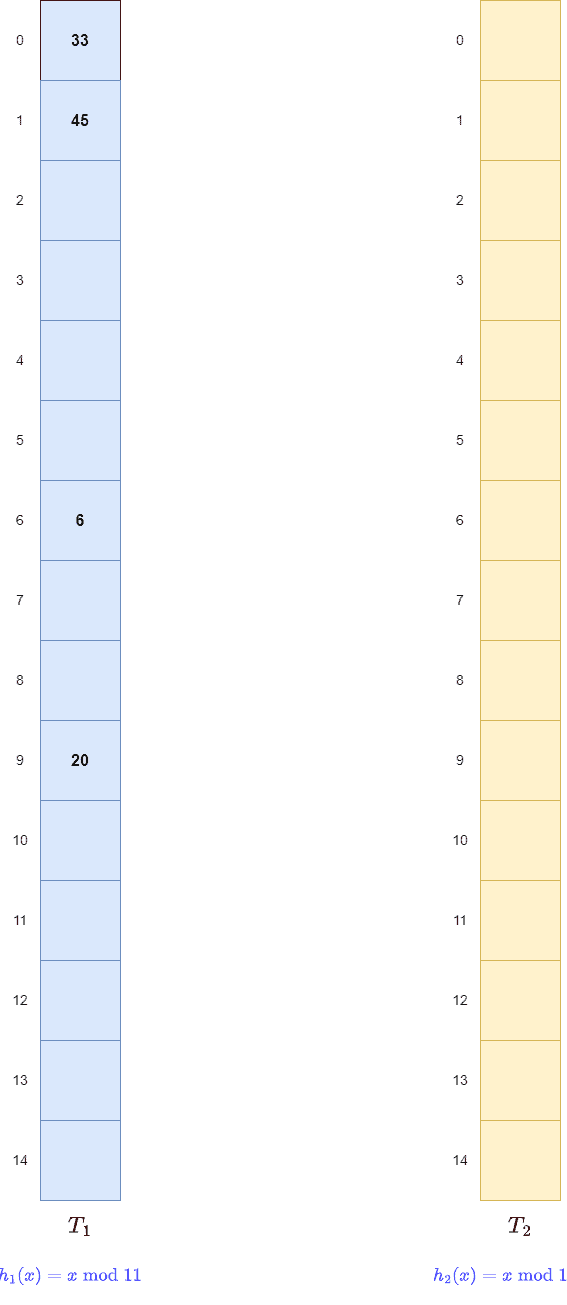 Next, key 61 maps t0
Next, key 61 maps t0 of
, but it is filled. So, like a cuckoo, we kick out the old key 6 and store key 61 there. Then, we apply
to the old key 6. This gives us
of
. As a result, we store it there and create a link between
of
and
of
:
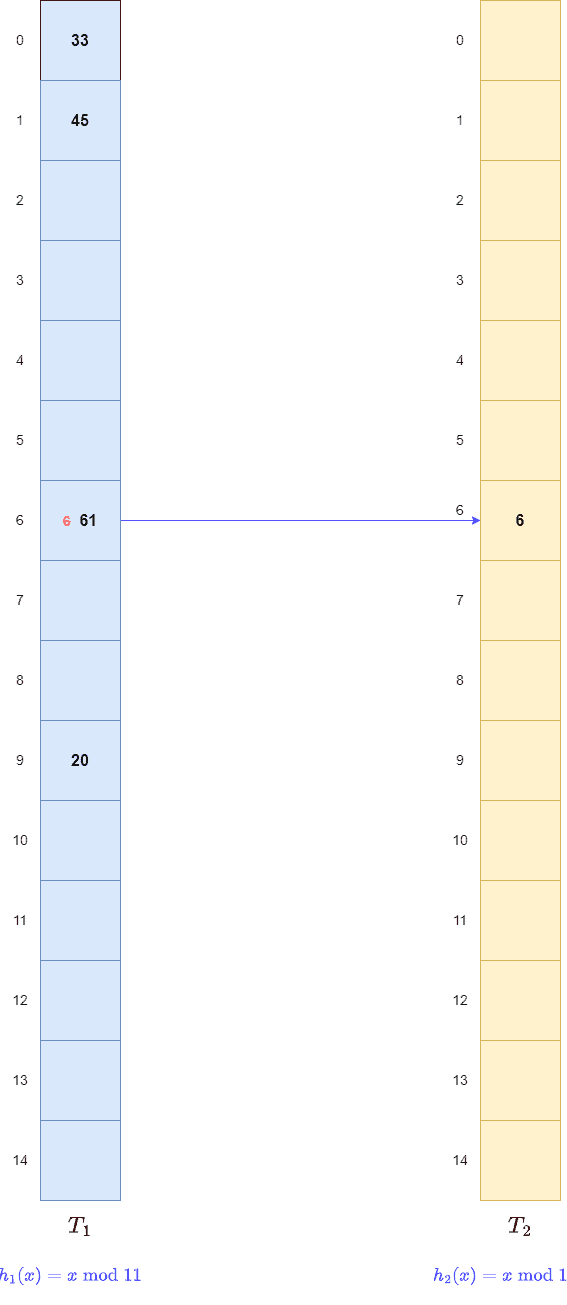 Again, for key 11, we find
Again, for key 11, we find of
filled with 33. So, we remove key 33 from there and store 11. Post that, we apply
to 33 and store it in
of
. We create a link between
of
and
of
:
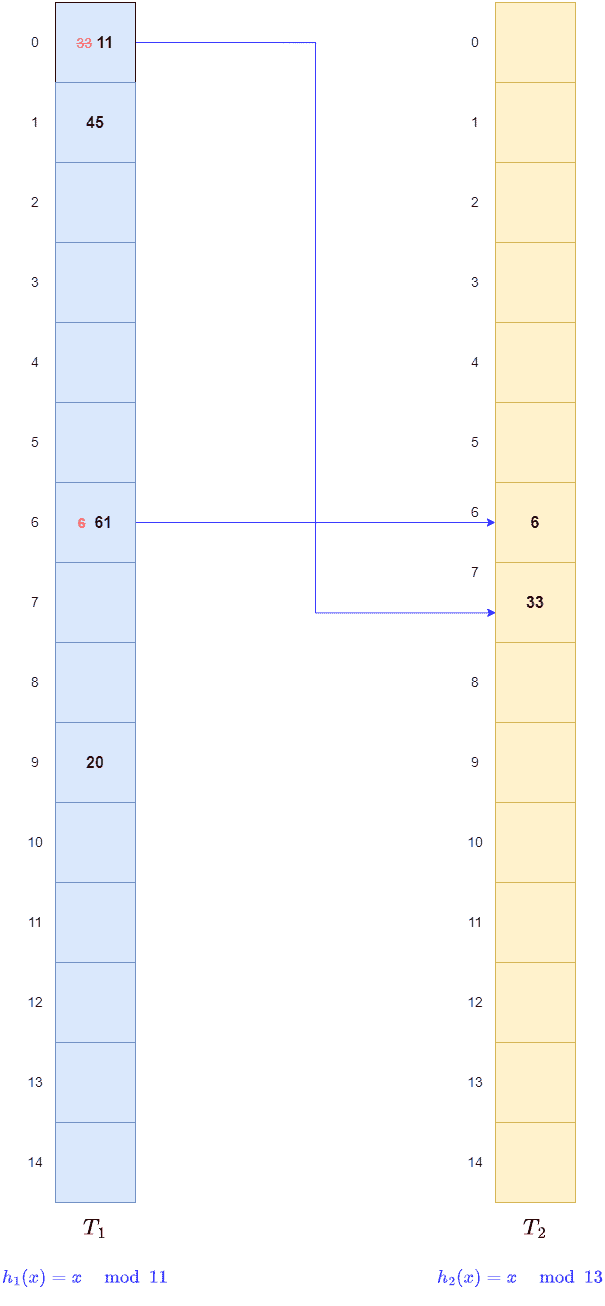 We continue this way until we reach the last key, 122:
We continue this way until we reach the last key, 122: 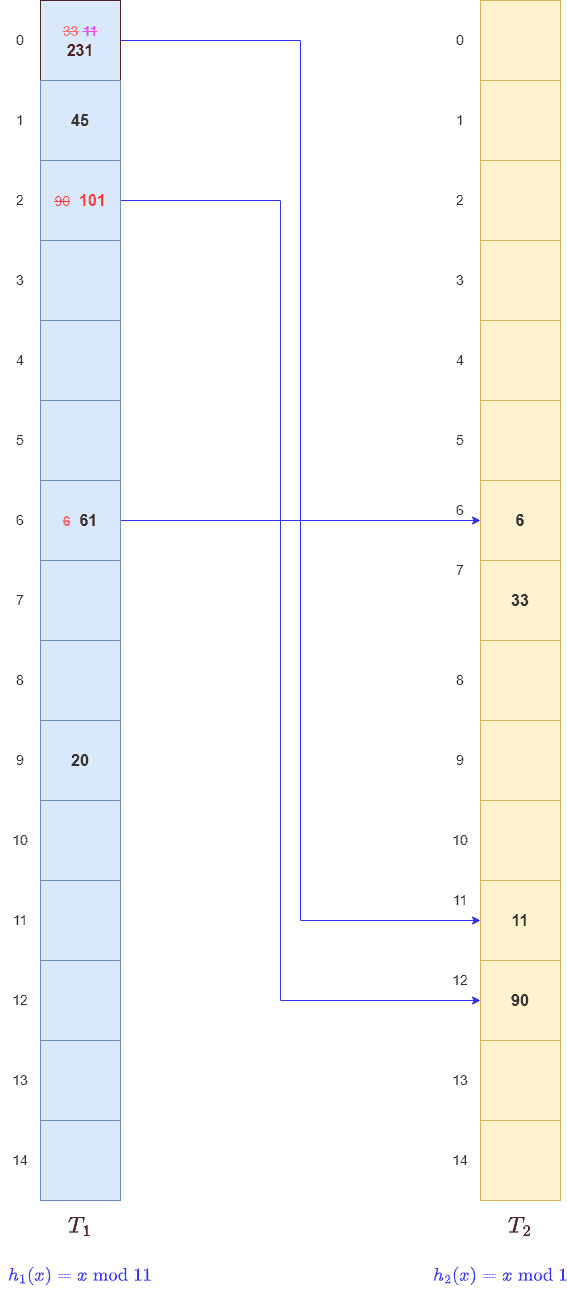 Here, we get
Here, we get of
, but this slot contains key 45. So, we remove 45 and store 122 there.
Next, we apply to key, 45 to get
of
. However, we find it filled with key 6. So, we remove the key 6 and remove the old link from
of
.
After that, we store key 45 there and create a link from of
to
of
. Next, we apply
on key 6 to get
of
. But it already contains the key 61. So, we remove key 61 and store key 6 there.
We also create a link from of
to
of
. Since
points to
of
, we apply
to key 61 and store it on empty
of
. We create a link from
of
to
of
:
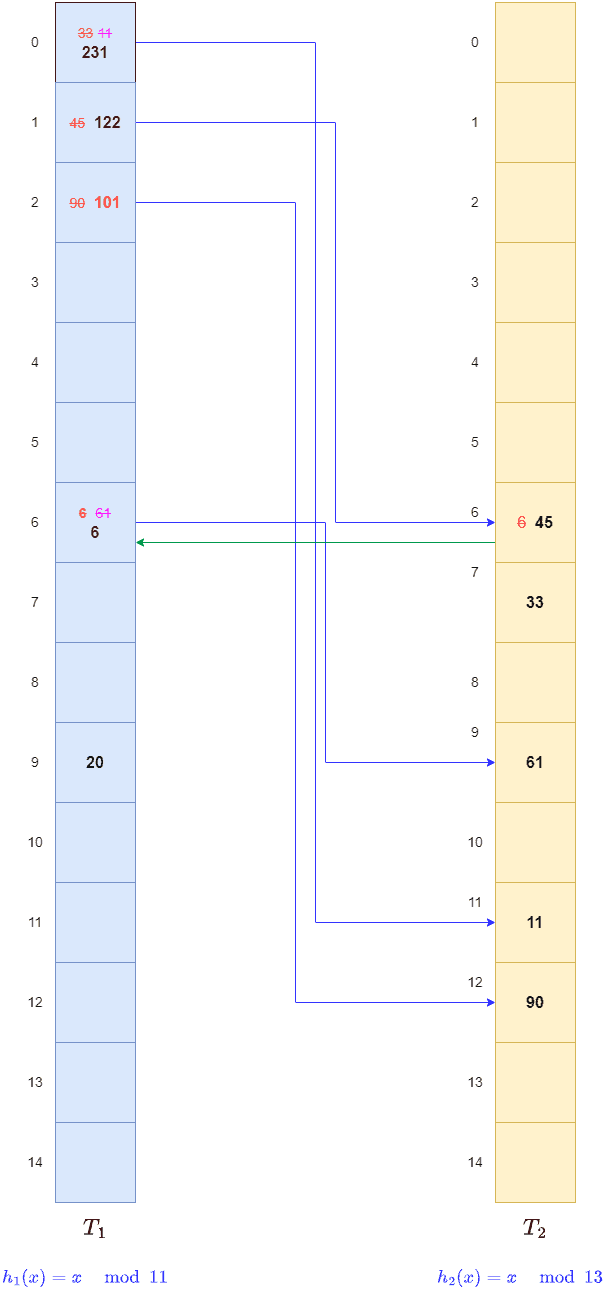 This way, we hashed all the keys.
This way, we hashed all the keys.
First, we apply our first hash function to the key. This gives us a slot in our first table. If the key is there, we stop. Otherwise, we apply our second hash function to the key and get a slot in the second table. If our key is hashed, it is there.
Let’s use the same example from the above section. Let’s say we search for 33. So, gives us slot
of
. But, we find key 231 there. So, we search our second table.
gives us slot
of
. There, we find our key.
We now look at the pseudocode for the search operation:
algorithm Search(k):
// INPUT
// k = the search key
// OUTPUT
// the slot and table in which k is or should be
tmp <- hash1(k)
if table1[tmp] = k:
// we found k in the first table table1
slot <- tmp
table <- table1
else:
// we try to find k in the second table table2
slot <- hash2(k)
table <- table2
return slot, tableThe time complexity for the search operation is in cuckoo hashing. This is so because we perform at most two lookup operations for any key.
In this article, we studied the intricacies of hashing in general and cuckoo hashing in particular. Cuckoo hashing is a closed-form hashing where we eliminate collisions by using two hash functions and two tables.